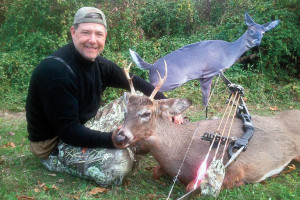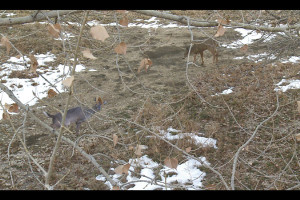September 07, 2014
By Fred Eichler
 I never thought I would consider a decoy a must-have part of my hunting equipment. I do now. In fact, I am rarely without one anymore. That is not to say that I always use one, but I do have one at the ready for when the right situation presents itself.
I never thought I would consider a decoy a must-have part of my hunting equipment. I do now. In fact, I am rarely without one anymore. That is not to say that I always use one, but I do have one at the ready for when the right situation presents itself.
The reason is that I have used decoys not only to harvest small game but also turkeys, whitetails, mule deer, antelope, and elk.
What I Look For
First and foremost, I want a realistic-looking decoy. If it doesn't look real to me, I feel it won't look good to an animal either. Next, I want something portable, lightweight, and quick and easy to set up. If a decoy doesn't have all of these attributes, I will rarely carry it.
Advertisement
When I Use Them
I use a decoy about 20 percent of the time when I'm hunting. That may not sound like much, but when I use them, it is because I need animals in close, and sometimes a decoy is the best weapon I have for making that happen. Not every situation is a decoy situation. I have the best luck using them in the rut.
If you have decoyed turkeys, you know that sometimes a gobbler will totally ignore your decoys. Other times a gobbler will try and breed one, if it's a hen decoy, or run in and demolish a gobbler or jake decoy. It all boils down to timing.
Advertisement
My other favorite time to use a decoy, besides the rut, is during the late season as a confidence builder. For example, if I am hunting pressured whitetails or mule deer over agriculture, I will place a decoy or two out in the field. It seems that entices the other deer to move into the field earlier.
I use the same tactic with late-season elk or pressured elk on public land. A lone elk decoy in a mountain meadow is sometimes just the ticket for luring in another elk.
Placement
 I think the biggest mistake or reason for failure when using a decoy is improper placement. For me, placing a decoy is a lot like putting up a treestand — it requires some thought and strategy.
I think the biggest mistake or reason for failure when using a decoy is improper placement. For me, placing a decoy is a lot like putting up a treestand — it requires some thought and strategy.
The first thing to check is if the animal you are trying to kill will even be able to see the decoy. Always check the line of sight. Since animals can approach from several angles, I try to have several line-of-sight areas open where I place my decoy so it can be seen from several positions.
I like to place decoys close to where I will be, because even if an animal hangs up 10 to 15 yards away from the decoy, it is still in range.
Conditions
In certain conditions I prefer not to use a decoy, even if the timing is right. If it is really windy, the lightweight decoys I like to use can blow over or bounce around so much they look unrealistic.
If it is snowing hard I don't use them, because decoys can get covered up, iced over, or sag unnaturally under the weight of the snow.
For me, the perfect weather conditions for using a decoy are on overcast days — bright sunlight on a decoy can make it look somewhat unrealistic — or when the wind is blowing steadily at five to 15 miles per hour.
Safety
You must use caution when using decoys. Since they look so realistic, they can often be mistaken for the real thing. This can be a safety hazard during any hunting season. Hunting from an elevated position is usually the safest way to use a decoy. Always be safety conscious and aware of other hunters, no matter if you are on private or public land.
Most animals I have decoyed end up broadside to the decoy, and most tend to circle or try to smell the decoy just like they would a live animal. For this reason, I always try to set up so I have a clear shot on the downwind side of my decoy.
Since animals usually circle downwind, I try to keep my decoy as free of human scent as I possibly can. If I am using a whitetail doe decoy, I will use some doe in heat or something else to keep a deer hanging out for a while.
It takes a little forethought, but by placing your decoy properly, you will have more close encounters and therefore more success.

